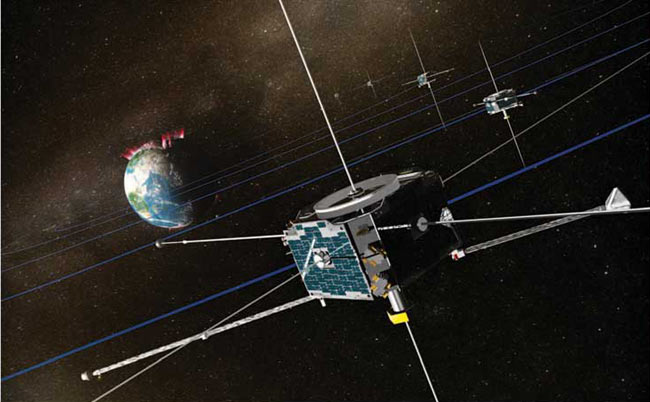
Five NASA probesaimed at unraveling mysteries surrounding Earth's colorful auroras are set to launch Fridayevening after a 24-hour weather delay.
VIDEO:Aurora - Dangerous Beauty
A United LaunchAlliance Delta 2 rocket carrying the fiveprobes that make up the Time History of Events and Macroscale InteractionsDuring Substorms (THEMIS)mission is scheduled to liftoff between 6:05 and 6:23 p.m. EST on Feb. 16 fromPad 17-B at Kennedy Space Center (KSC) in Florida. The launch will set a newNASA record for the most number of scientific satellites ever launched intoorbit aboard a single rocket. [VIDEO: THEMIS launch animation.]
"We'recomplete through all of our readiness reviews," KSC launch director Chuck Dovaletold reporters Thursday during a press conference. "The team is poised to startcountdown tomorrow and we're ready to go."
The probeswere originally set to launch on Thursday, Feb. 15, but thunderstorms and severeweather in the Cape Canaveral region the day before interrupted fueling of the rocket.
Weatherforecasters are optimistic that winds tonight will not reach beyond about 29mph (25 knots), which is the minimum requirement for a launch abort.
"I am lookingat a 20 percent 'no go' for tomorrow's launch based on wind," said Air Force weatherofficer Joel Tumbiolo. "That's 80 percent 'go.' That's a pretty good chanceright there."
Get the Space.com Newsletter
Breaking space news, the latest updates on rocket launches, skywatching events and more!
THEMISconsists of five identical probes [image],each about the size of a dishwasher and weighing nearly 300 pounds, that willspread out to form a unique constellation aimed at studying the auroraborealis and auroraaustralis--the colorful light shows that occur over Earth's northern andsouthern polar regions, respectively.
Undulatinglike rainbow ribbons in the sky, auroras are visible manifestations ofso-called "geomagnetic substorms" that occur in near-Earth space. These substormsare caused when electrically charged gas blown by the Sun's solar winds slam against Earth's magnetic shied, called the magnetosphere.
THEMIS willhelp answer scientific questions about when and where the substorms start, butit could also have practical implications, said Dick Fisher, director of NASA'sHelios Division. For example, Fisher said, airlines currently require pilotsflying over the North Pole to maintain constant communications. Ifcommunications is broken, as can occur during substorms, pilots are required toland their planes. Being able to predict when substorms might occur could thushelp airlines better plan their routes. [VIDEO: THEMIS mission overview.]
"To get ajetliner on the ground and make it stay overnight costs a lot of money," Fishersaid.
When theybegin data collection next winter, the five THEMIS probes [image]will align over North America once every four days [image],allowing 20 ground stations in Canada and Alaska to monitor substorms for 15 to20 hours at a stretch. Over the mission's two-year lifetime, the probes areexpected to observe some 30 substorms.
"We'relooking forward to the next challenge," aid UC Berkley's Peter Harvey, NASA'sTHEMIS project manager, "which is synchronizing all five spacecraft over NorthAmerica and keeping them humming along."
- VIDEO: THEMIS Launch Animation
- VIDEO: THEMIS Mission Overview
- IMAGES: Colorful Auroras
- NASA Primes Five Satellites for Stormy Hunt
- SPACE.com Cams: Real-time Views of the Sun, Earth and Auroras
- Storm Hunt: Spacecraft Quintet to Track Down Magnetic Field Tempests
Join our Space Forums to keep talking space on the latest missions, night sky and more! And if you have a news tip, correction or comment, let us know at: community@space.com.
Ker Than is a science writer and children's book author who joined Space.com as a Staff Writer from 2005 to 2007. Ker covered astronomy and human spaceflight while at Space.com, including space shuttle launches, and has authored three science books for kids about earthquakes, stars and black holes. Ker's work has also appeared in National Geographic, Nature News, New Scientist and Sky & Telescope, among others. He earned a bachelor's degree in biology from UC Irvine and a master's degree in science journalism from New York University. Ker is currently the Director of Science Communications at Stanford University.









